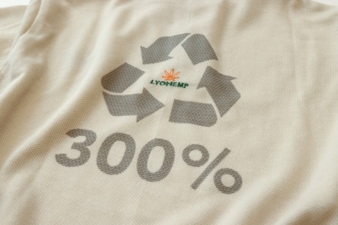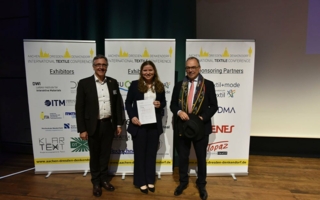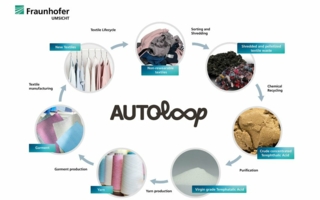01/08/2025 – World premiere — auf Deutsch lesen
First polo shirt made from triple-recycled cellulose fiber
TITK Rudolstadt is breaking new ground in textile recycling. At the World Expo in Osaka, Japan, the Thuringian research institute presented a polo shirt made from triple-recycled cellulose fibre.
The fibre used is also TITK's innovative Lyohemp – the first Lyocell fibre made from hemp pulp. TITK's managing director, Benjamin Redlingshöfer, proudly wore the polo shirt with the “300% recycling” print at the Expo in Osaka. 300% recycling means that the shirt is made from a fibre that has undergone three consecutive processing steps for the first time. And so successfully that it could be easily processed into a fashionable polo shirt of the highest quality. “With our 300% recycled fibre, we are demonstrating that closed textile recycling cycles are feasible thanks to our technology,” says Redlingshöfer. “This innovation proves that we can take recycling in the textile industry to a whole new level.”
Quality is maintained – even after triple recycling
When textiles are recycled at all, this often involves what is known as downcycling. This means that the originally high-quality textile fibres are used to manufacture textile products of lower quality as part of the material recycling process. The fibre-to-fibre recycling pursued at TITK, however, aims to produce a recycled fibre from a high-quality textile fibre with the same high level of quality and the same good usage properties. But even in these recycling cycles, only 20 to 40% of recycled materials are often mixed with a larger proportion of virgin grade material.
“TITK has now impressively demonstrated that not only 100% recycling of cellulose fibres is possible, but that this process can even be used three times in succession without compromising the desired characteristics of the fibre, such as a pleasant, soft feel, a slight sheen and very good, uniform dyeability,” says Redlingshöfer.
Recycling process also applicable to cotton
The result is a fully-fledged, sustainable product that now sets the standard for future recycling processes in the clothing industry. This will enable the consumption of new virgin-grade fibres to be drastically reduced in the future. This outstanding innovation was achieved thanks to a further adaptation of the institute's established, highly robust Lyocell process – specifically in terms of pulp extraction and pre-treatment, says Redlingshöfer. “In principle, this recycling cycle can also be applied to cotton fibres as a raw material.” TITK invites industry partners to work together on the further development and implementation of these technologies.





